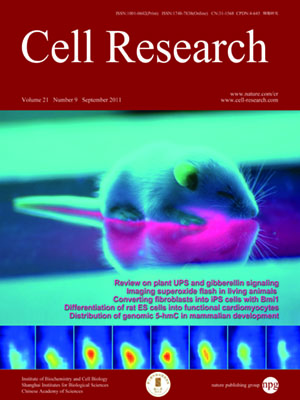
Volume 21, No 9, Sep 2011
ISSN: 1001-0602
EISSN: 1748-7838 2018
impact factor 17.848*
(Clarivate Analytics, 2019)
Volume 21 Issue 9, September 2011: 1332-1342
ORIGINAL ARTICLES
Lineage-specific distribution of high levels of genomic 5-hydroxymethylcytosine in mammalian development
Alexey Ruzov1,2, Yanina Tsenkina2, Andrea Serio3, Tatiana Dudnakova4, Judy Fletcher2, Yu Bai2, Tatiana Chebotareva2, Steve Pells2, Zara Hannoun2, Garet
1Wolfson Centre for Stem Cells, Tissue Engineering and Modelling, Centre for Biomolecular Sciences, University of Nottingham, University Park, Nottingham NG7 2RD, UK
2MRC Centre for Regenerative Medicine, University of Edinburgh, 49 Little France Crescent, Edinburgh EH16 4SB, UK
3Euan MacDonald Centre for Motor Neurone Disease Research, University of Edinburgh, 49 Little France Crescent, Edinburgh EH16 4SB, UK
4MRC Human Genetics Unit, Western General Hospital, Crewe Road, Edinburgh EH4 2XU, UK
5School of Chemistry, University of Edinburgh, West Mains Road, Edinburgh EH9 3JJ, UK
6Roslin Cells, Roslin Biocentre, Roslin, Midlothian, EH25 9PS, Edinburgh, UK
Correspondence: Alexey Ruzov, Paul De Sousa,(Alexey.Ruzov@nottingham.ac.uk; paul.desousa@ed.ac.uk)
Methylation of cytosine is a DNA modification associated with gene repression. Recently, a novel cytosine modification, 5-hydroxymethylcytosine (5-hmC) has been discovered. Here we examine 5-hmC distribution during mammalian development and in cellular systems, and show that the developmental dynamics of 5-hmC are different from those of 5-methylcytosine (5-mC); in particular 5-hmC is enriched in embryonic contexts compared to adult tissues. A detectable 5-hmC signal appears in pre-implantation development starting at the zygote stage, where the paternal genome is subjected to a genome-wide hydroxylation of 5-mC, which precisely coincides with the loss of the 5-mC signal in the paternal pronucleus. Levels of 5-hmC are high in cells of the inner cell mass in blastocysts, and the modification colocalises with nestin-expressing cell populations in mouse post-implantation embryos. Compared to other adult mammalian organs, 5-hmC is strongly enriched in bone marrow and brain, wherein high 5-hmC content is a feature of both neuronal progenitors and post-mitotic neurons. We show that high levels of 5-hmC are not only present in mouse and human embryonic stem cells (ESCs) and lost during differentiation, as has been reported previously, but also reappear during the generation of induced pluripotent stem cells; thus 5-hmC enrichment correlates with a pluripotent cell state. Our findings suggest that apart from the cells of neuronal lineages, high levels of genomic 5-hmC are an epigenetic feature of embryonic cell populations and cellular pluri- and multi-lineage potency. To our knowledge, 5-hmC represents the first epigenetic modification of DNA discovered whose enrichment is so cell-type specific.
Cell Research (2011) 21:1332-1342. doi:10.1038/cr.2011.113; published online 12 July 2011
FULL TEXT | PDF
Browse 2060


